
Chapter 3: Introduction to Pytorch & Neural Networks¶
By Tomas Beuzen 🚀

Chapter Outline¶
Chapter Learning Objectives¶
Describe the difference between
NumPyandtorcharrays (np.arrayvs.torch.Tensor).Explain fundamental concepts of neural networks such as layers, nodes, activation functions, etc.
Create a simple neural network in PyTorch for regression or classification.
Imports¶
import sys
import NumPy as np
import pandas as pd
import torch
from torchsummary import summary
from torch import nn, optim
from torch.utils.data import DataLoader, TensorDataset
from sklearn.datasets import make_regression, make_circles, make_blobs
from sklearn.preprocessing import StandardScaler
from sklearn.linear_model import LinearRegression
from utils.plotting import *
1. Introduction¶
PyTorch is a Python-based tool for scientific computing that provides several main features:
torch.Tensor, an n-dimensional array similar to that ofNumPy, but which can run on GPUsComputational graphs and an automatic differentiation enginge for building and training neural networks
You can install PyTorch from: https://pytorch.org/.
2. PyTorch’s Tensor¶
In PyTorch a tensor is just like NumPy’s ndarray which most readers will be familiar with already (if not, check out Chapter 5 and Chapter 6 of my Python Programming for Data Science course).
A key difference between PyTorch’s torch.Tensor and NumPy’s np.array is that torch.Tensor was constructed to integrate with GPUs and PyTorch’s computational graphs (more on that next chapter though).
2.1. ndarray vs tensor¶
Creating and working with tensors is much the same as with NumPy ndarrays. You can create a tensor with torch.tensor():
tensor_1 = torch.tensor([1, 2, 3])
tensor_2 = torch.tensor([1, 2, 3], dtype=torch.float32)
tensor_3 = torch.tensor(np.array([1, 2, 3]))
for t in [tensor_1, tensor_2, tensor_3]:
print(f"{t}, dtype: {t.dtype}")
tensor([1, 2, 3]), dtype: torch.int64
tensor([1., 2., 3.]), dtype: torch.float32
tensor([1, 2, 3]), dtype: torch.int64
PyTorch also comes with most of the NumPy functions you’re probably already familiar with:
torch.zeros(2, 2) # zeroes
tensor([[0., 0.],
[0., 0.]])
torch.ones(2, 2) # ones
tensor([[1., 1.],
[1., 1.]])
torch.randn(3, 2) # random normal
tensor([[-1.1988, -0.7157],
[-0.1942, -1.7273],
[-1.0674, 0.4149]])
torch.rand(2, 3, 2) # rand uniform
tensor([[[0.0583, 0.3669],
[0.0315, 0.9852],
[0.1880, 0.5039]],
[[0.0234, 0.7198],
[0.5472, 0.1252],
[0.1728, 0.3510]]])
Just like in NumPy we can look at the shape of a tensor with the .shape attribute:
x = torch.rand(2, 3, 2, 2)
x.shape
torch.Size([2, 3, 2, 2])
x.ndim
4
2.2. Tensors and Data Types¶
Different data types have different memory and computational implications (see Chapter 6 of Python Programming for Data Science for more). In Pytorch we’ll be building networks that require thousands or even millions of floating point calculations! In such cases, using a smaller dtype like float32 can significantly speed up computations and reduce memory requirements. The default float dtype in pytorch float32, as opposed to NumPy’s float64. In fact some operations in Pytorch will even throw an error if you pass a high-memory dtype!
print(np.array([3.14159]).dtype)
print(torch.tensor([3.14159]).dtype)
float64
torch.float32
But just like in NumPy, you can always specify the particular dtype you want using the dtype argument:
print(torch.tensor([3.14159], dtype=torch.float64).dtype)
torch.float64
2.3. Operations on Tensors¶
Tensors operate just like ndarrays and have a variety of familiar methods that can be called off them:
a = torch.rand(1, 3)
b = torch.rand(3, 1)
a + b # broadcasting betweean a 1 x 3 and 3 x 1 tensor
tensor([[1.3773, 1.5033, 1.1765],
[0.9496, 1.0756, 0.7488],
[1.3639, 1.4899, 1.1631]])
a * b
tensor([[0.4183, 0.5349, 0.2325],
[0.2249, 0.2876, 0.1250],
[0.4122, 0.5271, 0.2292]])
a.mean()
tensor(0.4272)
a.sum()
tensor(1.2816)
2.4. Indexing¶
Once again, same as NumPy!
X = torch.rand(5, 2)
print(X)
tensor([[0.2803, 0.1461],
[0.1740, 0.9460],
[0.1257, 0.3427],
[0.7001, 0.3810],
[0.6504, 0.6580]])
print(X[0, :])
print(X[0])
print(X[:, 0])
tensor([0.2803, 0.1461])
tensor([0.2803, 0.1461])
tensor([0.2803, 0.1740, 0.1257, 0.7001, 0.6504])
2.5. NumPy Bridge¶
Sometimes we might want to convert a tensor back to a NumPy array. We can do that using the .numpy() method:
X = torch.rand(3,3)
print(type(X))
X_NumPy = X.NumPy()
print(type(X_NumPy))
<class 'torch.Tensor'>
<class 'numpy.ndarray'>
2.6. GPU and CUDA Tensors¶
GPU stands for “graphical processing unit” (as opposed to a CPU: central processing unit). GPUs were originally developed for gaming, they are very fast at performing operations on large amounts of data by performing them in parallel (think about updating the value of all pixels on a screen very quickly as a player moves around in a game). More recently, GPUs have been adapted for more general purpose programming. Neural networks can typically be broken into smaller computations that can be performed in parallel on a GPU. PyTorch is tightly integrated with CUDA - a software layer that facilitates interactions with a GPU (if you have one). You can check if you have GPU capability using:
torch.cuda.is_available() # my MacBook Pro does not have a GPU
False
When training on a machine that has a GPU, you need to tell PyTorch you want to use it. You’ll see the following at the top of most PyTorch code:
device = torch.device('cuda' if torch.cuda.is_available() else 'cpu')
print(device)
cpu
You can then use the device argument when creating tensors to specify whether you wish to use a CPU or GPU. Or if you want to move a tensor between the CPU and GPU, you can use the .to() method:
X = torch.rand(2, 2, 2, device=device)
print(X.device)
cpu
# X.to('cuda') # this would give me an error as I don't have a GPU so I'm commenting out
We’ll revisit GPUs later in the course when we are working with bigger datasets and more complex networks. For now, we can work on the CPU just fine.
3. Neural Network Basics¶
It’s probably that you’ve already learned about several machine learning algorithms (kNN, Random Forest, SVM, etc.). Neural networks are simply another algorithm and actually one of the simplest in my opinion! As we’ll see, a neural network is just a sequence of linear and non-linear transformations. Often you see something like this when learning about/using neural networks:
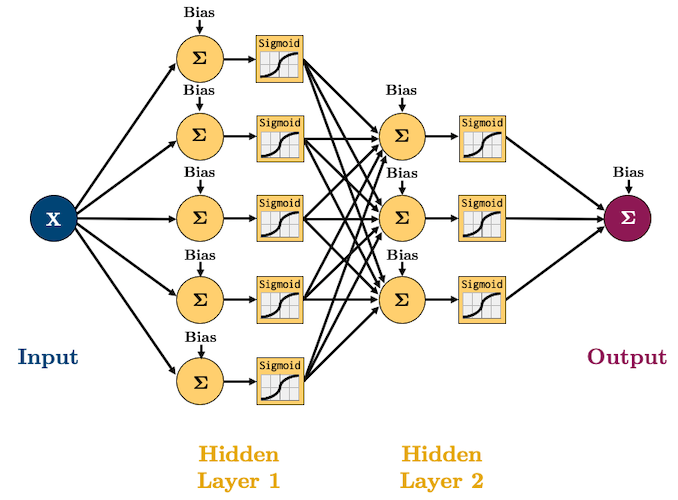
So what on Earth does that all mean? Well we are going to build up some intuition one step at a time.
3.1. Simple Linear Regression with a Neural Network¶
Let’s create a simple regression dataset with 500 observations:
X, y = make_regression(n_samples=500, n_features=1, random_state=0, noise=10.0)
plot_regression(X, y)
We can fit a simple linear regression to this data using sklearn:
sk_model = LinearRegression().fit(X, y)
plot_regression(X, y, sk_model.predict(X))
Here are the parameters of that fitted line:
print(f"w_0: {sk_model.intercept_:.2f} (bias/intercept)")
print(f"w_1: {sk_model.coef_[0]:.2f}")
w_0: -0.77 (bias/intercept)
w_1: 45.50
As an equation, that looks like this:
Or in matrix form:
Or in graph form I’ll represent it like this:
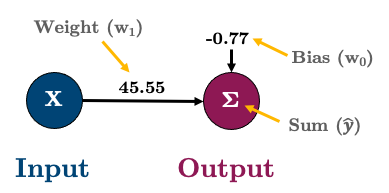
3.2. Linear Regression with a Neural Network in PyTorch¶
So let’s implement the above in PyTorch to start gaining an intuition about neural networks! Almost every neural network model you build in PyTorch will inherit from torch.nn.Module. If you’re unfamiliar with class inheritance check out this section of Python Programming for Data Science. Basically, inheritance allows us to inherit functionality from an existing class into a new class without having to write the code ourselves!
Let’s create a model called linearRegression and then I’ll walk you through the syntax:
class linearRegression(nn.Module): # our class inherits from nn.Module and we can call it anything we like
def __init__(self, input_size, output_size):
super().__init__() # super().__init__() makes our class inherit everything from torch.nn.Module
self.linear = nn.Linear(input_size, output_size) # this is a simple linear layer: wX + b
def forward(self, x):
out = self.linear(x)
return out
Let’s step through the above:
class linearRegression(nn.Module):
def __init__(self, input_size, output_size):
super().__init__()
^ Here we’re creating a class called linearRegression and inheriting the methods and attributes of nn.Module (hint: try typing help(linearRegression) to see all the things we inheritied from nn.Module).
self.linear = nn.Linear(input_size, output_size)
^ Here we’re defining a “Linear” layer, which just means wX + b, i.e., the weights of the network, multiplied by the input features plus the bias.
def forward(self, x):
out = self.linear(x)
return out
^ PyTorch networks created with nn.Module must have a forward() method. It accepts the input data x and passes it through the defined operations. In this case, we are passing x into our linear layer and getting an output out.
After defining the model class, we can create an instance of that class:
model = linearRegression(input_size=1, output_size=1)
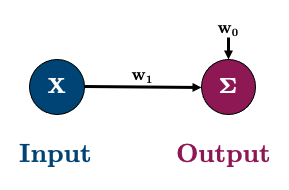
We can check out our model using print():
print(model)
linearRegression(
(linear): Linear(in_features=1, out_features=1, bias=True)
)
Or the more useful summary() (which we imported at the top of this notebook with from torchsummary import summary):
summary(model, (1,));
==========================================================================================
Layer (type:depth-idx) Output Shape Param #
==========================================================================================
├─Linear: 1-1 [-1, 1] 2
==========================================================================================
Total params: 2
Trainable params: 2
Non-trainable params: 0
Total mult-adds (M): 0.00
==========================================================================================
Input size (MB): 0.00
Forward/backward pass size (MB): 0.00
Params size (MB): 0.00
Estimated Total Size (MB): 0.00
==========================================================================================
Notice how we have two parameters? We have one for the weight (w1) and one for the bias (w0). These were initialized randomly by PyTorch when we created our model. They can be accessed with model.state_dict():
model.state_dict()
OrderedDict([('linear.weight', tensor([[-0.2427]])),
('linear.bias', tensor([0.0084]))])
Okay, before we move on, the x and y data I created are currently NumPy arrays but they need to be PyTorch tensors. Let’s convert them:
X_t = torch.tensor(X, dtype=torch.float32) # I'll explain requires_grad next Chapter
y_t = torch.tensor(y, dtype=torch.float32)
We have a working model right now and could tell it to give us some output with this syntax:
y_p = model(X_t[0]).item()
print(f"Predicted: {y_p:.2f}")
print(f" Actual: {y[0]:.2f}")
Predicted: -0.14
Actual: 31.08
Our prediction is pretty bad because our model is not trained/fitted yet! As we learned in the past few chapters, to fit our model we need:
a loss function (called “criterion” in PyTorch) to tell us how good/bad our predictions are - we’ll use mean squared error,
torch.nn.MSELoss()an optimization algorithm to help optimise model parameters - we’ll use GD,
torch.optim.SGD()
LEARNING_RATE = 0.1
criterion = nn.MSELoss() # loss function
optimizer = torch.optim.SGD(model.parameters(), lr=LEARNING_RATE) # optimization algorithm is SGD
Before we train I’m going to create a “data loader” to help batch my data. We’ll talk more about these in later chapters but just think of them as generators that yield data to us on request (if you’re unfamiliar with generators, check out this section of Python Programming for Data Science). We’ll use a BATCH_SIZE = 50 (which should give us 10 batches because we have 500 data points):
BATCH_SIZE = 50
dataset = TensorDataset(X_t, y_t)
dataloader = DataLoader(dataset, batch_size=BATCH_SIZE, shuffle=True)
So, we should have 10 batches:
print(f"Total number of batches: {len(dataloader)}")
Total number of batches: 10
We can look at a batch using this syntax:
XX, yy = next(iter(dataloader))
print(f" Shape of feature data (X) in batch: {XX.shape}")
print(f"Shape of response data (y) in batch: {yy.shape}")
Shape of feature data (X) in batch: torch.Size([50, 1])
Shape of response data (y) in batch: torch.Size([50])
With our data loader defined, let’s train our simple network for 5 epochs of SGD!
I’ll explain all the code here next chapter but scan throught it, it’s not too hard to see what’s going on!
def trainer(model, criterion, optimizer, dataloader, epochs=5, verbose=True):
"""Simple training wrapper for PyTorch network."""
for epoch in range(epochs):
losses = 0
for X, y in dataloader:
optimizer.zero_grad() # Clear gradients w.r.t. parameters
y_hat = model(X).flatten() # Forward pass to get output
loss = criterion(y_hat, y) # Calculate loss
loss.backward() # Getting gradients w.r.t. parameters
optimizer.step() # Update parameters
losses += loss.item() # Add loss for this batch to running total
if verbose: print(f"epoch: {epoch + 1}, loss: {losses / len(dataloader):.4f}")
trainer(model, criterion, optimizer, dataloader, epochs=5, verbose=True)
epoch: 1, loss: 135.1689
epoch: 2, loss: 20.1312
epoch: 3, loss: 18.7327
epoch: 4, loss: 18.7078
epoch: 5, loss: 18.6989
Now our model has been trained, our parameters should be different than before:
model.state_dict()
OrderedDict([('linear.weight', tensor([[45.4260]])),
('linear.bias', tensor([-1.2242]))])
Comparing to the sklearn model, we get a very similar answer:
pd.DataFrame({"w0": [sk_model.intercept_, model.state_dict()['linear.bias'].item()],
"w1": [sk_model.coef_[0], model.state_dict()['linear.weight'].item()]},
index=['sklearn', 'pytorch']).round(2)
| w0 | w1 | |
|---|---|---|
| sklearn | -0.77 | 45.50 |
| pytorch | -1.22 | 45.43 |
We got pretty close! We could do better by changing the number of epochs or the learning rate. So here is our simple network once again:

By the way, check out what happens if we run trainer() again:
trainer(model, criterion, optimizer, dataloader, epochs=5, verbose=True)
epoch: 1, loss: 18.7552
epoch: 2, loss: 18.7638
epoch: 3, loss: 18.7314
epoch: 4, loss: 18.7215
epoch: 5, loss: 18.7264
Our model continues where we left off! This may or may not be what you want. We can start from scratch by re-making our model and optimizer.
3.3. Multiple Linear Regression with a Neural Network¶
Okay, let’s do a multiple linear regression now with 3 features. So our network will look like this:
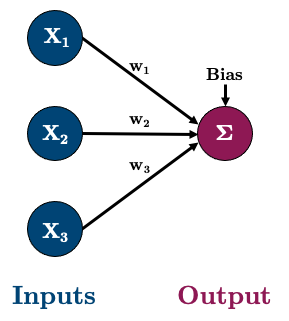
Let’s go ahead and create some data:
# Create dataset
X, y = make_regression(n_samples=500, n_features=3, random_state=0, noise=10.0)
X_t = torch.tensor(X, dtype=torch.float32)
y_t = torch.tensor(y, dtype=torch.float32)
# Create dataloader
dataset = TensorDataset(X_t, y_t)
dataloader = DataLoader(dataset, batch_size=BATCH_SIZE, shuffle=True)
And let’s create the above model:
model = linearRegression(input_size=3, output_size=1)
We should now have 4 parameters (3 weights and 1 bias):
summary(model, (3,));
==========================================================================================
Layer (type:depth-idx) Output Shape Param #
==========================================================================================
├─Linear: 1-1 [-1, 1] 4
==========================================================================================
Total params: 4
Trainable params: 4
Non-trainable params: 0
Total mult-adds (M): 0.00
==========================================================================================
Input size (MB): 0.00
Forward/backward pass size (MB): 0.00
Params size (MB): 0.00
Estimated Total Size (MB): 0.00
==========================================================================================
Looks good to me! Let’s train the model and then compare it to sklearn’s LinearRegression():
criterion = nn.MSELoss()
optimizer = torch.optim.SGD(model.parameters(), lr=LEARNING_RATE)
trainer(model, criterion, optimizer, dataloader, epochs=5, verbose=True)
epoch: 1, loss: 201.4410
epoch: 2, loss: 22.4213
epoch: 3, loss: 20.4116
epoch: 4, loss: 20.5035
epoch: 5, loss: 20.5471
sk_model = LinearRegression().fit(X, y)
pd.DataFrame({"w0": [sk_model.intercept_, model.state_dict()['linear.bias'].item()],
"w1": [sk_model.coef_[0], model.state_dict()['linear.weight'][0, 0].item()],
"w2": [sk_model.coef_[1], model.state_dict()['linear.weight'][0, 1].item()],
"w3": [sk_model.coef_[2], model.state_dict()['linear.weight'][0, 2].item()]},
index=['sklearn', 'pytorch']).round(2)
| w0 | w1 | w2 | w3 | |
|---|---|---|---|---|
| sklearn | 0.43 | 0.62 | 55.99 | 11.14 |
| pytorch | 0.28 | 0.53 | 55.98 | 11.10 |
3.4. Non-linear Regression with a Neural Network¶
Okay so we’ve made simple networks to imitate simple and multiple linear regression. You’re probably thinking, so what? But we’re getting to the good stuff I promise! For example, what happens when we have more complicated datasets like this?
# Create dataset
np.random.seed(2020)
X = np.sort(np.random.randn(500))
y = X ** 2 + 15 * np.sin(X) **3
X_t = torch.tensor(X[:, None], dtype=torch.float32)
y_t = torch.tensor(y, dtype=torch.float32)
# Create dataloader
dataset = TensorDataset(X_t, y_t)
dataloader = DataLoader(dataset, batch_size=BATCH_SIZE, shuffle=True)
plot_regression(X, y, y_range=[-25, 25], dy=5)
This is obviously non-linear, and we need to introduce some non-linearities into our network. These non-linearities are what make neural networks so powerful and they are called “activation functions”. We are going to create a new model class that includes a non-linearity - a sigmoid function:
def sigmoid(x):
return 1 / (1 + np.exp(-x))
xs = np.linspace(-15, 15, 100)
plot_regression(xs, [0], sigmoid(xs), x_range=[-5, 5], y_range=[0, 1], dy=0.2)
We’ll talk more about activation functions later, but note how the sigmoid function non-linearly maps x to a value between 0 and 1. Okay, so let’s create the following network:
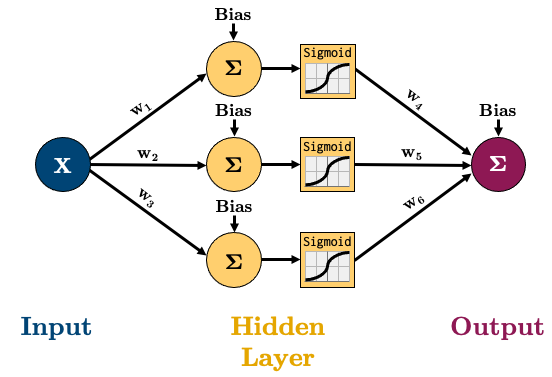
All this means is that the value of each node in the hidden layer will be transformed by the “activation function”, thus introducing non-linear elements to our model! There’s two main ways of creating the above model in PyTorch, I’ll show you both:
class nonlinRegression(nn.Module):
def __init__(self, input_size, hidden_size, output_size):
super().__init__()
self.hidden = nn.Linear(input_size, hidden_size)
self.output = nn.Linear(hidden_size, output_size)
self.sigmoid = nn.Sigmoid()
def forward(self, x):
x = self.hidden(x) # input -> hidden layer
x = self.sigmoid(x) # sigmoid activation function in hidden layer
x = self.output(x) # hidden -> output layer
return x
Note how our forward() method now passes x through the nn.Sigmoid() function after the hidden layer. The above method is very clear and flexible, but I prefer using nn.Sequential() to combine my layers together in the constructor:
class nonlinRegression(nn.Module):
def __init__(self, input_size, hidden_size, output_size):
super().__init__()
self.main = torch.nn.Sequential(
nn.Linear(input_size, hidden_size), # input -> hidden layer
nn.Sigmoid(), # sigmoid activation function in hidden layer
nn.Linear(hidden_size, output_size) # hidden -> output layer
)
def forward(self, x):
x = self.main(x)
return x
Let’s make an instance of our new class and confirm it has 10 parameters (6 weights + 4 biases):
model = nonlinRegression(1, 3, 1)
summary(model, (1,));
==========================================================================================
Layer (type:depth-idx) Output Shape Param #
==========================================================================================
├─Sequential: 1-1 [-1, 1] --
| └─Linear: 2-1 [-1, 3] 6
| └─Sigmoid: 2-2 [-1, 3] --
| └─Linear: 2-3 [-1, 1] 4
==========================================================================================
Total params: 10
Trainable params: 10
Non-trainable params: 0
Total mult-adds (M): 0.00
==========================================================================================
Input size (MB): 0.00
Forward/backward pass size (MB): 0.00
Params size (MB): 0.00
Estimated Total Size (MB): 0.00
==========================================================================================
Okay, let’s train:
criterion = nn.MSELoss()
optimizer = torch.optim.SGD(model.parameters(), lr=0.3)
trainer(model, criterion, optimizer, dataloader, epochs=5, verbose=True)
epoch: 1, loss: 5.9213
epoch: 2, loss: 3.0709
epoch: 3, loss: 1.5621
epoch: 4, loss: 1.3159
epoch: 5, loss: 1.5005
y_p = model(X_t).detach().NumPy().squeeze()
plot_regression(X, y, y_p, y_range=[-25, 25], dy=5)
Take a look at those non-linear predictions! Cool! Our model is not great and we could make it better soon by adjusting the learning rate, the number of nodes, and the number of epochs. But I really want you to see how each of our hidden nodes is “engineering a non-linear feature” to be used for the predictions, check it out:
plot_nodes(X, y_p, model)
3.5. Deep Learning¶
You’ve probably heard the magic term “deep learning” and you’re about to find out what it means! Really, it’s just a neural network with more than 1 hidden layer! Easy!
I like to think of each layer in a neural network as a “feature engineerer”, it is trying to extract the maximum amount of information from the layer before it. There are arguments of “deep network” (many layers) vs “wide network” (many nodes), but for big datasets, “deep networks” have been shown to be very effective in practice
Let’s create a “deep” network of 2 layers:

class deepRegression(nn.Module):
def __init__(self, input_size, hidden_size_1, hidden_size_2, output_size):
super().__init__()
self.main = nn.Sequential(
nn.Linear(input_size, hidden_size_1),
nn.Sigmoid(),
nn.Linear(hidden_size_1, hidden_size_2),
nn.Sigmoid(),
nn.Linear(hidden_size_2, output_size)
)
def forward(self, x):
out = self.main(x)
return out
model = deepRegression(1, 5, 3, 1)
optimizer = torch.optim.SGD(model.parameters(), lr=0.3)
trainer(model, criterion, optimizer, dataloader, epochs=20, verbose=False)
plot_regression(X, y, model(X_t).detach(), y_range=[-25, 25], dy=5)
Above, note that just because the network is deeper, doesn’t always mean it’s better!
4. Activation Functions¶
As we learned above, activation functions are what allow us to model complex, non-linear functions. There are many different activations functions:
functions = [torch.nn.Sigmoid, torch.nn.Tanh, torch.nn.Softplus, torch.nn.ReLU, torch.nn.LeakyReLU, torch.nn.SELU]
plot_activations(torch.linspace(-6, 6, 100), functions)
Activation functions should be non-linear and tend to be monotonic and continuously differentiable (smooth). But as you can see with the ReLU function above, that’s not always the case!
I wanted to point this out because it highlights how much of an art deep learning really is. Here’s a great quote from Yoshua Bengio (famous for his work in AI and deep learning) on his group experimenting with ReLU:
“…one of the biggest mistakes I made was to think, like everyone else in the 90s, that you needed smooth non-linearities in order for backpropagation to work. because I thought that if we had something like rectifying nonlinearities, where you have a flat part, that it would be really hard to train, because the derivative would be zero in so many places. And when we started experimenting with ReLU, with deep nets around 2010, I was obsessed with the idea that, we should be careful about whether neurons won’t saturate too much on the zero part. But in the end, it turned out that, actually, the ReLU was working a lot better than the sigmoids and tanh, and that was a big surprise…it turned out to work better, whereas I thought it would be harder to train!”
Anyway, ReLU is probably the most popular these days, but you can treat activation functions as hyperparameters that need to be optimized in your workflow.
5. Neural Network Classification¶
5.1. Binary Classification¶
This will actually be the easiest part of the chapter. Up until now, we’ve been looking at developing networks for regression tasks, but what if we want to do binary classification? Well, what do we do in Logistic Regression? We just pass the output of a regression model into the Sigmoid function to get a value between 0 and 1 (a probability of an observation belonging to the positive class) - we’ll do the same thing here!
Let’s create a toy dataset:
X, y = make_circles(n_samples=300, factor=0.5, noise=0.1, random_state=2020)
X_t = torch.tensor(X, dtype=torch.float32)
y_t = torch.tensor(y, dtype=torch.float32)
# Create dataloader
dataset = TensorDataset(X_t, y_t)
dataloader = DataLoader(dataset, batch_size=BATCH_SIZE, shuffle=True)
plot_classification_2d(X, y)
Let’s create this network to model that dataset:
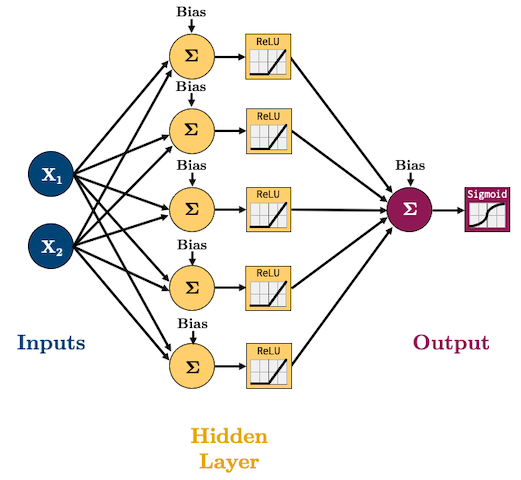
I’m going to start using ReLU as our activation function(s) and Adam as our optimizer because these are what are currently, commonly used in practice. We are doing classification now so we’ll need to use log loss (binary cross entropy) as our loss function:
In PyTorch, the binary cross entropy loss criterion is torch.nn.BCELoss. The formula expects a “probability” which is why we add a Sigmoid function to the end of out network.
class binaryClassifier(nn.Module):
def __init__(self, input_size, hidden_size, output_size):
super().__init__()
self.main = nn.Sequential(
nn.Linear(input_size, hidden_size),
nn.ReLU(),
nn.Linear(hidden_size, output_size),
nn.Sigmoid() # <-- this will squash our output to a probability between 0 and 1
)
def forward(self, x):
out = self.main(x)
return out
BUT WAIT!
While we can do the above and then train with a torch.nn.BCELoss loss function, there’s a better way! We can omit the Sigmoid function and just use torch.nn.BCEWithLogitsLoss (which combines a Sigmoid layer and the BCELoss). Why would we do this? It’s numerically stable! From the docs:
“This version is more numerically stable than using a plain Sigmoid followed by a BCELoss as, by combining the operations into one layer, we take advantage of the log-sum-exp trick for numerical stability.”
So with that said, here’s our model (no Sigmoid layer at the end because it’s included in the loss function we’ll use):
class binaryClassifier(nn.Module):
def __init__(self, input_size, hidden_size, output_size):
super().__init__()
self.main = nn.Sequential(
nn.Linear(input_size, hidden_size),
nn.ReLU(),
nn.Linear(hidden_size, output_size)
)
def forward(self, x):
out = self.main(x)
return out
Let’s train the model:
model = binaryClassifier(2, 5, 1)
criterion = torch.nn.BCEWithLogitsLoss() # loss function
optimizer = torch.optim.Adam(model.parameters(), lr=LEARNING_RATE) # optimization algorithm
trainer(model, criterion, optimizer, dataloader, epochs=20, verbose=True)
epoch: 1, loss: 0.0766
epoch: 2, loss: 0.0663
epoch: 3, loss: 0.0532
epoch: 4, loss: 0.0420
epoch: 5, loss: 0.0339
epoch: 6, loss: 0.0287
epoch: 7, loss: 0.0249
epoch: 8, loss: 0.0204
epoch: 9, loss: 0.0178
epoch: 10, loss: 0.0152
epoch: 11, loss: 0.0125
epoch: 12, loss: 0.0116
epoch: 13, loss: 0.0097
epoch: 14, loss: 0.0085
epoch: 15, loss: 0.0080
epoch: 16, loss: 0.0074
epoch: 17, loss: 0.0070
epoch: 18, loss: 0.0067
epoch: 19, loss: 0.0064
epoch: 20, loss: 0.0061
plot_classification_2d(X, y, model)
To be clear, our model is just outputting some number between -∞ and +∞ (we aren’t applying Sigmoid in the model), so:
To get the probabilities we would need to pass them through a Sigmoid;
To get classes, we can apply some threshold (usually 0.5) to this probability.
For example, we would expect the point (0,0) to have a high probability and the point (-1,-1) to have a low probability:
prediction = model(torch.tensor([[0, 0], [-1, -1]], dtype=torch.float32)).detach()
print(prediction)
tensor([[ 5.7085],
[-12.6671]])
probability = nn.Sigmoid()(prediction)
print(probability)
tensor([[9.9669e-01],
[3.1533e-06]])
classes = np.where(probability > 0.5, 1, 0)
print(classes)
[[1]
[0]]
5.2. Multiclass Classification (Optional)¶
For multiclass classification, we’ll need the softmax function:
It basically outputs probabilities for each class we wish to predict, and they all sum to 1. If you’re not familiar with the different loss functions we’re using in this chapter, I highly recommend you read through this excellent blog post. torch.nn.CrossEntropyLoss is a loss that combines a softmax with cross entropy loss. Let’s try a 4-class classification problem using the following network:
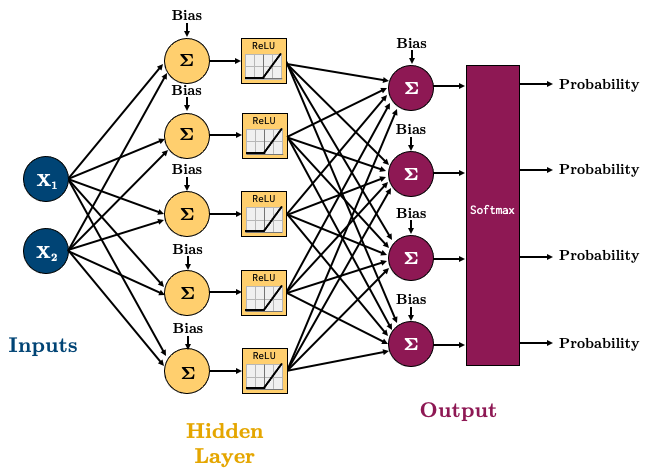
class multiClassifier(torch.nn.Module):
def __init__(self, input_size, hidden_size, output_size):
super().__init__()
self.main = torch.nn.Sequential(
torch.nn.Linear(input_size, hidden_size),
torch.nn.ReLU(),
torch.nn.Linear(hidden_size, output_size)
)
def forward(self, x):
out = self.main(x)
return out
X, y = make_blobs(n_samples=200, centers=4, center_box=(-1.2, 1.2), cluster_std=[0.15, 0.15, 0.15, 0.15], random_state=12345)
X_t = torch.tensor(X, dtype=torch.float32)
y_t = torch.tensor(y, dtype=torch.int64)
# Create dataloader
dataset = TensorDataset(X_t, y_t)
dataloader = DataLoader(dataset, batch_size=BATCH_SIZE, shuffle=True)
plot_classification_2d(X, y)
Let’s train this model:
model = multiClassifier(2, 5, 4)
criterion = torch.nn.CrossEntropyLoss() # loss function
optimizer = torch.optim.Adam(model.parameters(), lr=0.2) # optimization algorithm
for epoch in range(10):
losses = 0
for X_batch, y_batch in dataloader:
optimizer.zero_grad() # Clear gradients w.r.t. parameters
y_hat = model(X_batch) # Forward pass to get output
loss = criterion(y_hat, y_batch) # Calculate loss
loss.backward() # Getting gradients w.r.t. parameters
optimizer.step() # Update parameters
losses += loss.item() # Add loss for this batch to running total
print(f"epoch: {epoch + 1}, loss: {losses / len(dataloader):.4f}")
epoch: 1, loss: 0.1076
epoch: 2, loss: 0.0715
epoch: 3, loss: 0.0493
epoch: 4, loss: 0.0355
epoch: 5, loss: 0.0262
epoch: 6, loss: 0.0192
epoch: 7, loss: 0.0099
epoch: 8, loss: 0.0046
epoch: 9, loss: 0.0029
epoch: 10, loss: 0.0015
plot_classification_2d(X, y, model, transform="Softmax")
To be clear once again, our model is just outputting some number between -∞ and +∞, so:
To get the probabilities we would need to pass them to a Softmax;
To get classes, we need to select the largest probability.
For example, we would expect the point (-1,-1) to have a high probability of belonging to class 1, and the point (0,0) to have the highest probability of belonging to class 2.
prediction = model(torch.tensor([[-1, -1], [1,1]], dtype=torch.float32)).detach()
print(prediction)
tensor([[-11.2613, 14.0553, -3.2340, -51.9501],
[ -2.0350, -3.3383, 1.7017, 3.7850]])
Note how we get 4 predictions per data point (a prediction for each of the 4 classes):
probability = nn.Softmax(dim=1)(prediction)
print(probability)
tensor([[1.0119e-11, 1.0000e+00, 3.1001e-08, 2.1588e-29],
[2.6301e-03, 7.1445e-04, 1.1036e-01, 8.8629e-01]])
The predictions should now sum to 1:
probability.sum(dim=1)
tensor([1., 1.])
We can get the class with maximum probability using argmax():
classes = probability.argmax(dim=1)
print(classes)
tensor([1, 3])
